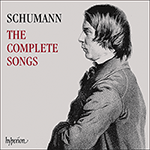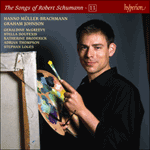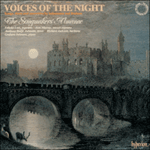
Welcome to Hyperion Records, an independent British classical label devoted to presenting high-quality recordings of music of all styles and from all periods from the twelfth century to the twenty-first.
Hyperion offers both CDs, and downloads in a number of formats. The site is also available in several languages.
Please use the dropdown buttons to set your preferred options, or use the checkbox to accept the defaults.

| Hanno Müller-Brachmann (baritone), Graham Johnson (piano)» More |
There was a side of Schumann that was lost in a subjective day-dream, but there was also a more ambitious part of his personality that planned his career to a fault: thus the lieder of 1840 were self-consciously followed by new chapters: the symphony in 1841 and chamber music in 1842. It is very clear that for all his altruism it mattered greatly to him how he was regarded by the outside world; the careful fostering of the Robert–Clara legend is evidence enough of this. If the works of the left-wing rabble-rouser Heine from Hamburg, and the Catholic Silesian Eichendorff were inspired literary choices on the part of the Saxon Schumann, a poet like Reinick seems like a literary choice selected to befit a composer who aspired to the status of a national figure, someone transcending the state boundaries that had so long served German art with such variety and distinction. Reinick’s poems represented a more central, if rather anodyne and artificial, tradition in the same way that Disneyland’s mythology and the castle of Cinderella may claim to represent the history of a United States without a history of his own. In hymning the Rhine and the Fatherland Reinick steps outside the time-honoured concept of the regional poet and provides lyrics for an emerging Germany that are much more generalized: this is not a real country (at least not as yet) but rather a concept—Germany united by cosy religiosity on the banks of the Rhine, the mighty river in itself symbolic of the nation and a source of legend. In this kind of fairy-tale land all is sweetness and light ‘mit Lust und Liedern’; lovers always become wives, and the elves play their part in revealing to the poet that what he needs above all is a pure-of-heart German girl. Of course Reinick was not the only poet to write on these topics in this way, but his Gedichte had early success partly because of the appealing and atmospheric drawings that went along with them.
from notes by Graham Johnson © 2009
Marqué à chanter «dans le style populaire», l’énergique air de marche d’«An den Sonnenschein» valut à ce lied de devenir vite l’un des préférés du public. Hormis une pointe de réflexion vers la fin, sa musique optimisme, de plein air, semble faire fi de l’isolement mélancolique du poète. «Dichters Genesung» reprend une fois encore le grand mythe de la Lorelei. Mais contrairement à ce qui se passe dans «Waldesgespräch», il y a une fin heureuse, le poète revenant à lui lors d’une petite marche animée, qu’accompagne le passage du mystère en mineur au simple éclat du majeur. Pour clore ce corpus d’après Reinick, le fervent «Liebesbotschaft» est, de l’aveu même de Schumann, une lettre d’amour à Clara. Au début, le compositeur souligne toute l’importance que ce lied revêt pour lui en citant une phrase du «Liebeszauber» («Magie de l’amour») de Clara.
extrait des notes rédigées par Richard Wigmore © 2012
Français: Hypérion
Die robuste Marschmelodie von „An den Sonnenschein“ soll „Im Volkston“ gesungen werden und erfreute sich bald beträchtlicher Popularität. Mit Ausnahme von ein wenig Nachdenklichkeit gegen Ende scheint Schumanns optimistische Al-Fresco-Musik die melancholische Isolation des Dichters nicht zu beachten. „Dichters Genesung“ ist eine weitere Version der Loreley-Sage. Anders als beim „Waldesgespräch“ ist das Ende hier jedoch glücklich, wenn der Dichter in einem nüchternem kleinen Marsch—in dem ebenfalls ein Wechsel von der Rätselhaftigkeit in Moll zu der unkomplizierten Dur-Helligkeit stattfindet—zu sich kommt. Das letzte dieser Reinick-Lieder, die inbrünstige „Liebesbotschaft“, ist, wie Schumann selbst preisgab, ein Liebesbrief an Clara. Zu Beginn unterstreicht er die persönliche Bedeutung, indem er eine Phrase aus Claras Lied „Liebeszauber“ zitiert.
aus dem Begleittext von Richard Wigmore © 2012
Deutsch: Viola Scheffel
 Schumann: The Complete Songs Schumann: The Complete SongsSchumann’s songs are among the greatest musical achievements of the nineteeth century, and this is the perfect release with which to mark the composer’s 200th birthday. This marvellous collection comprises Schumann’s complete songs, presented for ...» More |
 Schumann: The Complete Songs, Vol. 11 - Hanno Müller-Brachmann Schumann: The Complete Songs, Vol. 11 - Hanno Müller-BrachmannGraham Johnson’s monumental and triumphant complete Schumann Songs edition comes to an end with this eleventh disc, featuring Hanno Müller-Brachmann. A devoted lieder singer who has performed with some of the world’s greatest pianists, Brachmann i ...» More |
 Brahms & Schumann: Voices of the Night Brahms & Schumann: Voices of the Night‘A very special experience’ (The Daily Telegraph) ‘Immaculate … delicious’ (Hi-Fi News)» More |

